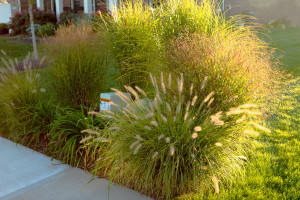March 3, 2017
 Some homeowners grow ornamental grasses in their gardens because many they retain their beauty or sculptural interest even through the winter. However, not all grasses are pretty when they go dormant and snow and ice arrive. Should some grasses be trimmed in winter?
Some homeowners grow ornamental grasses in their gardens because many they retain their beauty or sculptural interest even through the winter. However, not all grasses are pretty when they go dormant and snow and ice arrive. Should some grasses be trimmed in winter?
The answer to the question is, generally, no, ornamental grasses shouldn’t be trimmed in winter. This applies to warm and cool season grasses.
Warm Season Grasses
Warm season grasses begin their growth in the middle of spring to the early weeks of summer and start to flower when temperatures are hot. The grasses then go to seed and turn brown, and if they are unattractive, fall is the time to trim them back. If they’re not trimmed in the fall, the gardener should wait and trim them in very early spring while they’re still dormant. They should be trimmed back fairly hard, with only an inch or two remaining above the ground.
Warm season ornamentals include Spartina, Fountain Grass, Switch Grass, Northern Sea Oats, types of Grama Grass, Japanese Silver Grass, Graybeard Grass, and Indian grass.
Cool Season Grasses
As their name suggests, cool season grasses grow in early spring and fall after the last frost of the former and the first frost of the latter. They dislike heat and don’t grow much in the height of summer. Because these grasses are attractive even in winter, the gardener should wait till spring to trim them. However, they should not be cut back as hard as warm season grasses. The gardener should remove about two thirds of the plant. If the winter has been mild, the grass can be cut in the very last days of the season.
Cool season grasses include Blue Oat Grass, Golden Foxtail Grass, Tufted Hair Grass, varieties of Fescue, Blue Meadow Grass, Autumn Moor Grass, and Green Needle Grass.
How to Trim Grass
Grass that doesn’t grow very tall can be trimmed with pruning shears. The blades must be sharp to avoid crushing the stems of the plant as opposed to delivering a clean cut. Crushing invites disease and pests. Taller grasses can be bundled together with their tops tied. This allows the stalks to be cut in one fell swoop, and in the end the gardener can just pick up the bundle and toss it in the compost bin or pack it in the truck to take it to the recycling place.
Some gardeners use power tools such as hedge trimmers or weed whackers to deal with tall grasses, while some still use scythes. Experts recommend using weed whackers with a blade as opposed to a string. Other gardeners make do with bread knives or pruning saws.
It’s also important for the gardener to be dressed properly when it comes time to trim ornamental grasses. Some of these grasses are razor sharp, and it’s imperative to wear thick, heavy gloves, long pants, long sleeves, and eye protection, especially if power tools are being used to remove them.
Gallery
“We recommend Twin Oaks to any entity looking for a full-service, talented, and responsive provider.”
